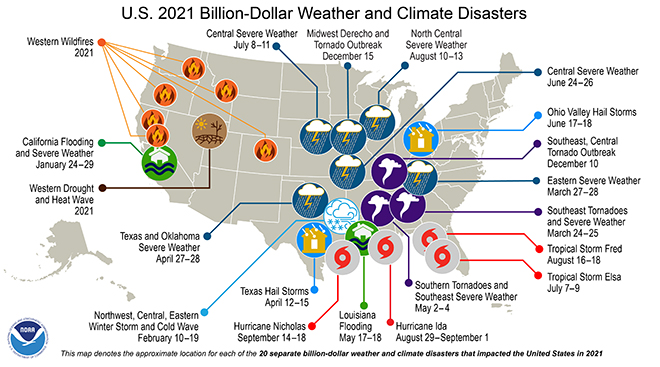S&P Global Offerings
Featured Topics
Featured Products
Events
S&P Global Offerings
Featured Topics
Featured Products
Events
S&P Global Offerings
Featured Topics
Featured Products
Events
Banking & Capital Markets
Economy & Finance
Energy Transition & Sustainability
Technology & Innovation
Podcasts & Newsletters
Banking & Capital Markets
Economy & Finance
Energy Transition & Sustainability
Technology & Innovation
Podcasts & Newsletters
S&P Global Offerings
Featured Topics
Featured Products
Events
12 Jan, 2022
By Karin Rives
U.S. weather and climate-related disasters reached $145 billion in 2021 — with Hurricane Ida alone costing $75 billion — sending a message to industry and policymakers that hurricanes, drought and floods continue to wreak havoc on lives and critical infrastructure.
In all, 688 people died in such major disasters last year, more than twice as many as in 2020, NOAA's National Centers for Environmental Information reported Jan. 10. The agency plans to release its full annual U.S. climate report Jan. 13.
The NOAA report fueled new calls by climate advocates and Democratic lawmakers to Congress to pass the $1.7 trillion Build Back Better legislation that is in limbo after Sen. Joe Manchin, D-W.V., joined Senate Republican in declining to back the bill. The package includes $555 billion for climate programs that are part of President Joe Biden's agenda to halve U.S. emissions by 2030.
"Climate change is killing our economy," Bob Keefe, executive director of the clean economy-focused business group E2, said in a statement. "This new data shows we cannot afford to wait any longer to stem its growing costs."
There were 20 weather-related events costing $1 billion or more in 2021, making it the third-costliest year on record. The Category 4 Hurricane Ida in September that left New Orleans without power for days caused $2.4 billion in losses for Entergy Louisiana LLC, also showing the growing financial pressure utilities face as storms multiply.

The world's second-largest emitter of greenhouse gas emissions, the U.S. risks falling farther behind climate targets the country pledged under the Paris Agreement on climate change, the Rhodium Group warned in a report the same day NOAA released its disaster tally. Total U.S. greenhouse gas emissions soared by 6.2% in 2021, fueled in part by a resurgence in coal-fired power generation, the Rhodium Group reported.
Most of the U.S. logged warmer temperatures than normal in 2021 with states like Maine and New Hampshire recording their second-warmest year on record, NOAA found. Nearly 15% of the country had the warmest June on record, followed by a record-warm December for 10 states in the middle and south-central part of the nation.
At the same time, above-normal precipitation — another result of warming global temperatures, scientists say — led to heavy snowfall in the central Rockies and the wettest July on record in southern Arizona with flash floods and fatalities as a result. Rains in the western United States brought some welcome relief to drought-stricken California, NOAA noted.
Since the U.S. government began to track weather and climate disasters in 1980, the country has suffered 310 events each with a price tag of $1 billion or more.
